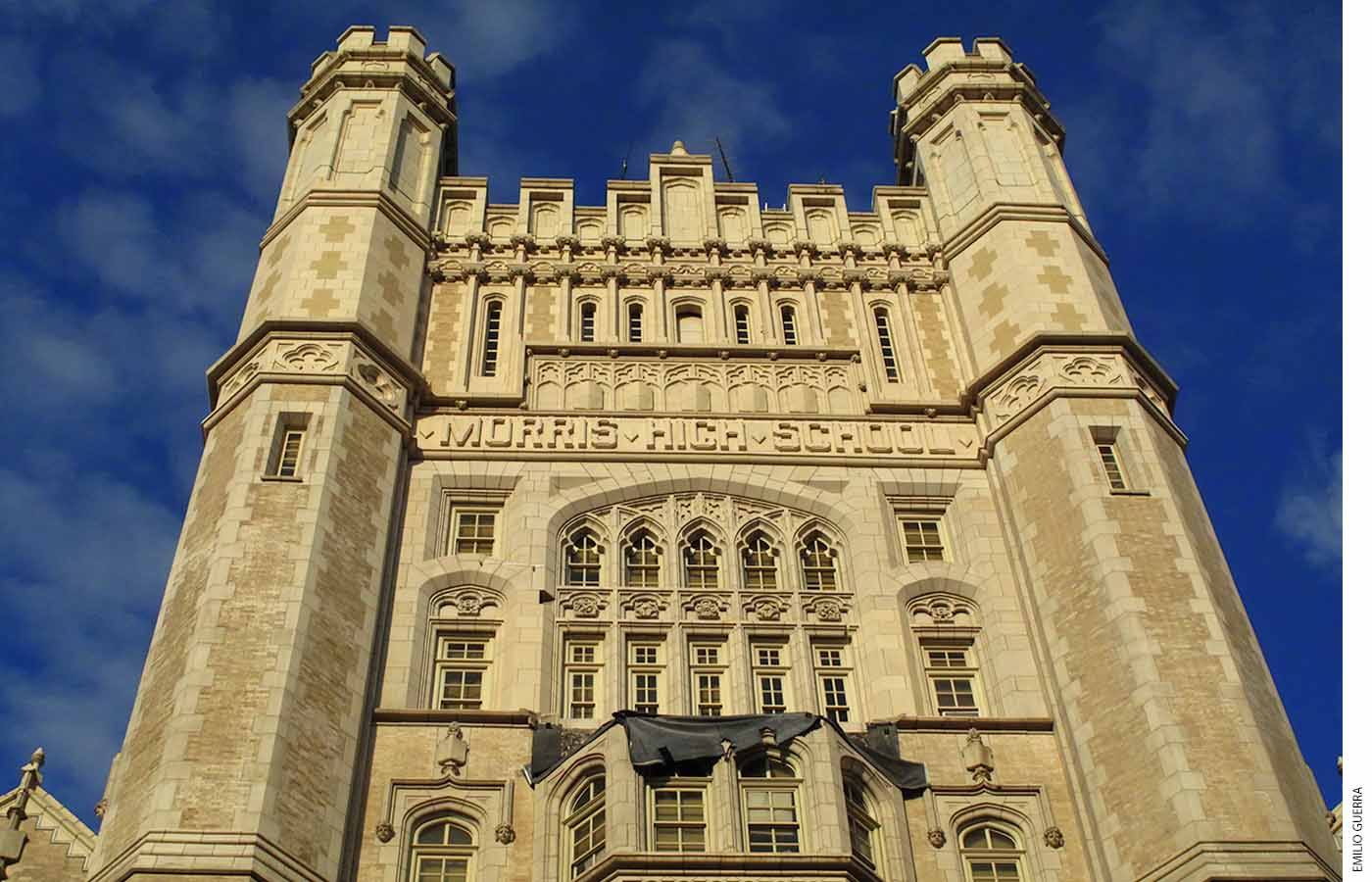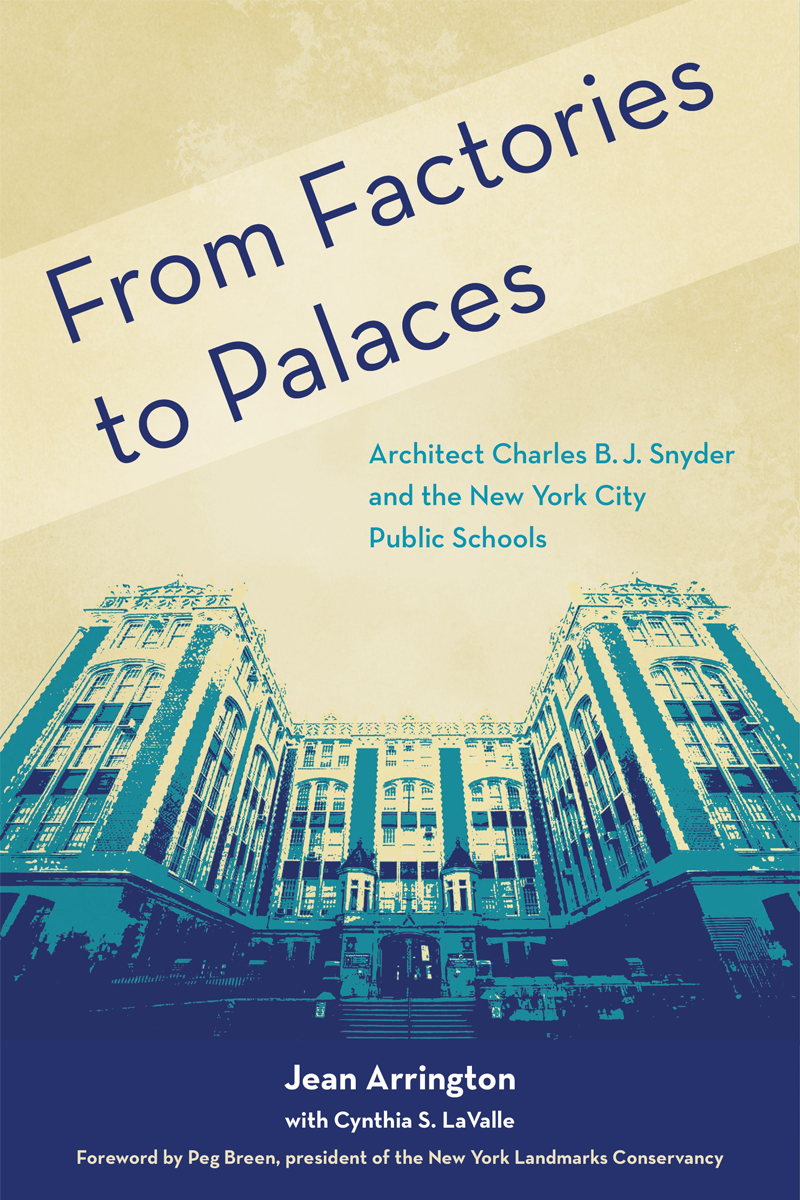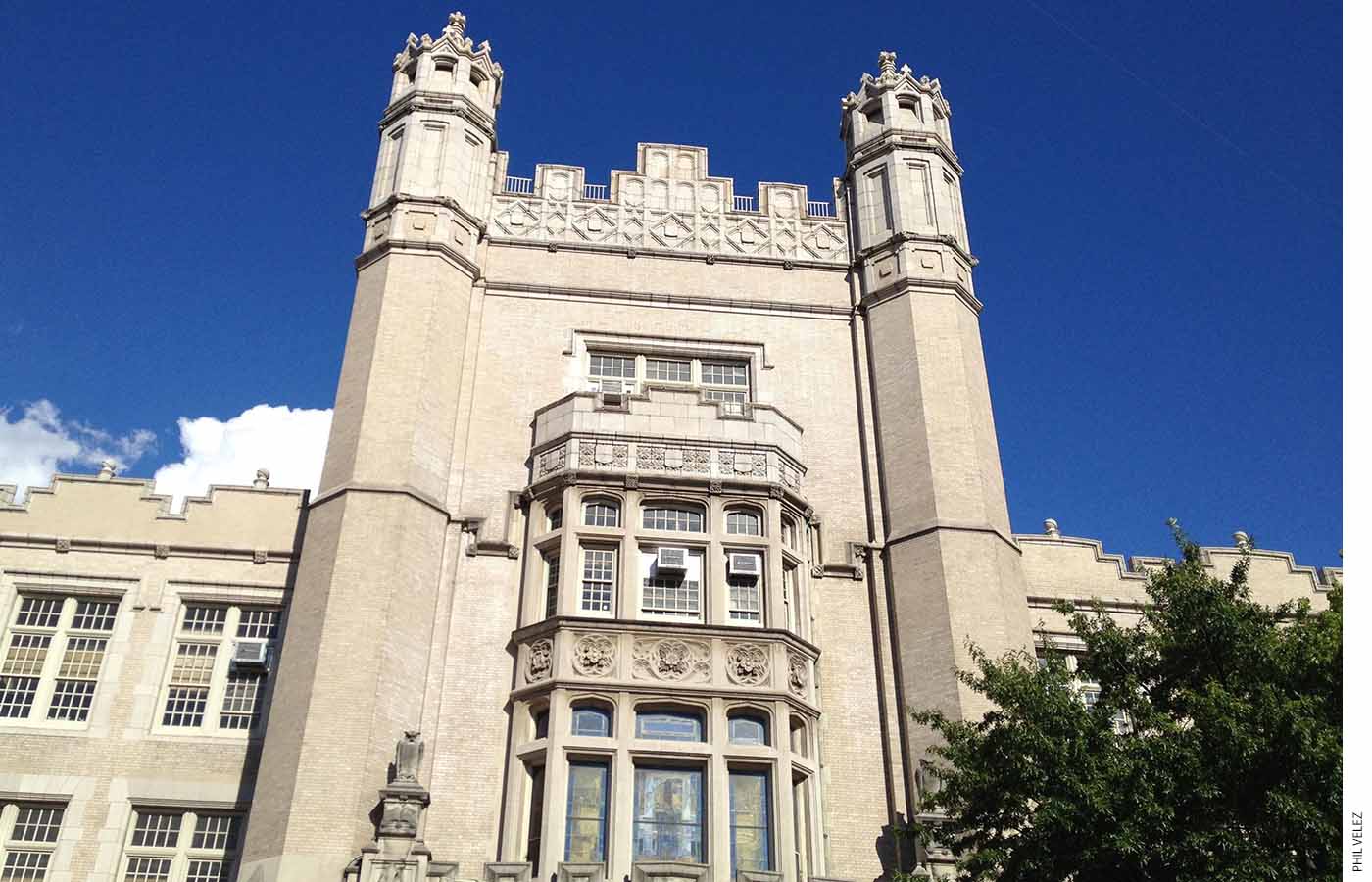
From Factories to Palaces: Architect Charles B. J. Snyder and the New York City Public Schools
Fordham University Press, 2022, $39.95; 272 pages.
by Jean Arrington with Cynthia S. LaValle
As reviewed by Stephen Eide
From Factories to Palaces, a biography of school architect C. B. J. Snyder, opens a view onto a lost and glorious world of public education in New York City. Early 20th-century Progressives believed that mass public education could combine democracy and excellence. Their hopes shaped the 408 new schools and additions that Snyder designed during his 1891 to 1922 tenure as New York’s superintendent of school buildings. To a degree, Progressives’ hopes were fulfilled. Some Snyder schools, such as Erasmus Hall and Morris High, would produce long lists of notable alumni despite being neighborhood, not exam schools. Snyder biographer Jean Arrington invites us to consider the contribution that design makes to excellence in education.
Three factors accounted for the extravagant scale of Snyder’s school building program. The first two were the revenues pouring into the city treasury and the pressures of surging enrollment. In the current era, New York’s traditional district schools have been losing students since 2016, and that trend is expected to continue. In Snyder’s day, school enrollment was growing by 25,000 students every year. During Snyder’s most productive period, 1899–1914, enrollment almost doubled, and appropriations tripled. When the building program was going at full stride, a new Snyder-designed school was opening every 23 days.
 The third factor was the Progressive movement’s high ambitions for public education. More kids were going to school, not just because of immigration but on account of child labor laws and the increasing normalization of high school. Progressives didn’t want schools to settle for teaching basic numeracy and literacy. Thus, school buildings had to become complex, and move away from the former “one-room schoolhouse” design paradigm of undifferentiated space to one of multiple specialized spaces and features. Snyder and his fellow Progressives embraced vocational education—far more so than 21st century school departments—which necessitated spaces for training in carpentry, dressmaking, millinery, and plumbing. The Progressives also, with equal fervor, embraced intellectual and artistic achievement for its own sake. That necessitated libraries, laboratories, study halls, music rooms, and art studios. Snyder’s crowd was enthusiastic about gymnasiums and playgrounds, and not only to help kids blow off steam but to teach sportsmanship and fair play, traditionally considered to be aristocratic values. Snyder and the Progressives pushed to improve the Jacob Riisian conditions of the 19th-century schools’ physical plant, the bad lighting, the classrooms with no desks, the “inadequate and filthy bathrooms.”
The third factor was the Progressive movement’s high ambitions for public education. More kids were going to school, not just because of immigration but on account of child labor laws and the increasing normalization of high school. Progressives didn’t want schools to settle for teaching basic numeracy and literacy. Thus, school buildings had to become complex, and move away from the former “one-room schoolhouse” design paradigm of undifferentiated space to one of multiple specialized spaces and features. Snyder and his fellow Progressives embraced vocational education—far more so than 21st century school departments—which necessitated spaces for training in carpentry, dressmaking, millinery, and plumbing. The Progressives also, with equal fervor, embraced intellectual and artistic achievement for its own sake. That necessitated libraries, laboratories, study halls, music rooms, and art studios. Snyder’s crowd was enthusiastic about gymnasiums and playgrounds, and not only to help kids blow off steam but to teach sportsmanship and fair play, traditionally considered to be aristocratic values. Snyder and the Progressives pushed to improve the Jacob Riisian conditions of the 19th-century schools’ physical plant, the bad lighting, the classrooms with no desks, the “inadequate and filthy bathrooms.”
Sad to say, the author of From Factories to Palaces, Jean Arrington, died just a few months before the book’s publication. Her book will help revive interest in C. B. J. Snyder, a name mostly unknown in public education circles, even though about 20 percent of New York public school students still learn in one of the schools he built. The Encyclopedia of New York City has no entry for Snyder, a striking oversight for a man whose contribution to New York’s built environment gives Robert Moses a run for his money.
The most interesting discussions in the book center on Snyder’s conception of schools as community centers. He built elaborate, ground-floor auditoriums to host evening educational programs for schools’ immigrant communities. Attendance was strong: “The school system offered single lectures and series of lectures on topics such as great composers, the value of vaccinations, the development of Japan as a nation, and New York architecture, complete with lantern slides. In 1903 alone, one million working men and women attended 3,300 lectures, the majority held in public schools.” What takes shape here is a vision of civic unity achieved through the promotion of a culture both shared and elevated. Our society today is more fractured, and the prospects are dimmer for both immigrant assimilation and high culture (now considered a counterculture). We have come to expect less of our schools. If schools everywhere could achieve basic numeracy and literacy, even if only that, we’d be thrilled. Still, it is worth observing that the Progressive movement’s achievements were real. There was once an era when Americans could and did have nice things.

Snyder had no distinct architectural style, but he was consistent in the effect he was going for. He wanted his schools to stand out, to draw the attention of passers-by. The point of the “Collegiate Gothic” style was to evoke for ordinary public school students images of Oxford, Cambridge, and Princeton. He wanted his spaces to feel so grand that students, when they arrived each morning, would feel the need to adjust their behavior without having to be told, the way most of us do upon entering a church. Snyder imparted a cathedral-like feeling to his schools through ornamentation, such as the stained-glass representations of Erasmus in the “Elizabethan banqueting hall” auditorium in the school named after the Dutch philosopher. Over the years, some of the uplifting effect of Snyder’s designs has been diminished by the metal detectors the city installed in some of his erstwhile “cathedrals of culture.”
“Snyder participated in a new century like no other, reflected in grand municipal architecture, full of promise and hope, of possibility unhampered by cynicism,” Arrington writes. Of course, many modern readers will find it quaint to read how Progressive Era school officials, at least some of them, hoped to address substantive problems like truancy through larger windows, the elimination of backless benches, and Italian palazzo flourishes. Today we—even the lowercase “p” progressives among us—are more cynical than the early 20th-century Progressives. We know now that school performance takes much more than careful design. But our heightened cynicism (or realism, if you like) guarantees that we’ll never build schools that create as much civic pride as Snyder’s once did.
Stephen Eide is a senior fellow at the Manhattan Institute and the author of Homelessness in America: The History and Tragedy of an Intractable Social Problem (2022).
This article appeared in the Fall 2022 issue of Education Next. Suggested citation format:
Eide, S. (2022). Palatial Schools for the Progressive Era: C. B. J. Snyder designed “grand municipal architecture full of promise and hope.” Education Next, 22(4), 76-77.


